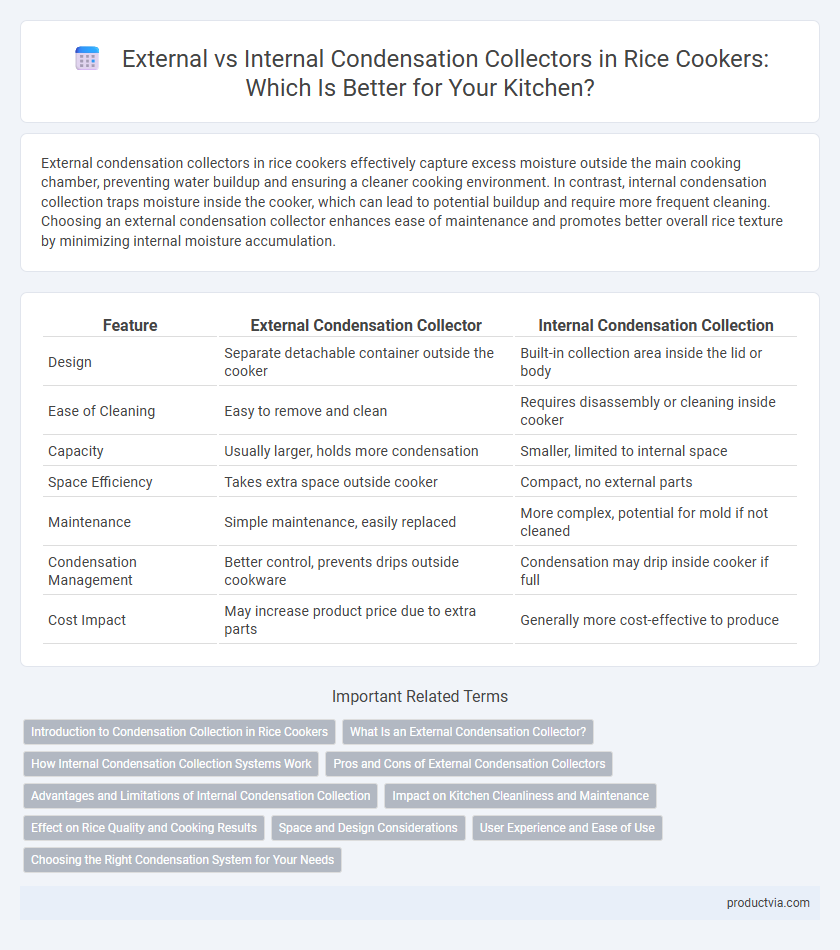External condensation collectors in rice cookers effectively capture excess moisture outside the main cooking chamber, preventing water buildup and ensuring a cleaner cooking environment. In contrast, internal condensation collection traps moisture inside the cooker, which can lead to potential buildup and require more frequent cleaning. Choosing an external condensation collector enhances ease of maintenance and promotes better overall rice texture by minimizing internal moisture accumulation.
Table of Comparison
| Feature | External Condensation Collector | Internal Condensation Collection |
|---|---|---|
| Design | Separate detachable container outside the cooker | Built-in collection area inside the lid or body |
| Ease of Cleaning | Easy to remove and clean | Requires disassembly or cleaning inside cooker |
| Capacity | Usually larger, holds more condensation | Smaller, limited to internal space |
| Space Efficiency | Takes extra space outside cooker | Compact, no external parts |
| Maintenance | Simple maintenance, easily replaced | More complex, potential for mold if not cleaned |
| Condensation Management | Better control, prevents drips outside cookware | Condensation may drip inside cooker if full |
| Cost Impact | May increase product price due to extra parts | Generally more cost-effective to produce |
Introduction to Condensation Collection in Rice Cookers
Rice cookers use condensation collection systems to manage excess moisture produced during cooking, ensuring optimal texture and preventing water buildup inside the appliance. External condensation collectors capture steam outside the main body, simplifying cleaning and reducing internal moisture that can lead to mold or rust. Internal condensation collection integrates moisture collection within the cooker's inner chamber, allowing for compact design but requiring regular maintenance to avoid residue accumulation.
What Is an External Condensation Collector?
An external condensation collector in rice cookers is a dedicated compartment or container located outside the main cooking chamber designed to capture excess moisture released during the cooking process. This system prevents water from dripping inside the cooker, thereby reducing mess and making cleanup easier. External collectors improve the cooker's hygiene by minimizing internal moisture accumulation that can lead to residue buildup or mold growth.
How Internal Condensation Collection Systems Work
Internal condensation collection systems in rice cookers operate by directing steam generated during cooking into a designated internal chamber, where moisture condenses and is absorbed or evaporated within the device. This design reduces mess and eliminates the need for manual water disposal, enhancing user convenience and maintaining cleaner kitchen surfaces. Compared to external condensation collectors, internal systems enable a more compact rice cooker construction and improve overall durability by preventing water leakage.
Pros and Cons of External Condensation Collectors
External condensation collectors in rice cookers effectively capture excess moisture, preventing water from spilling onto countertops, which keeps the cooking area clean and reduces the risk of electrical damage. These collectors are easier to clean and maintain compared to internal systems, as they can be detached and washed separately, enhancing hygiene. However, external collectors may increase the appliance's overall size, making storage less convenient, and can sometimes cause inconvenience if not emptied regularly during prolonged cooking cycles.
Advantages and Limitations of Internal Condensation Collection
Internal condensation collection in rice cookers efficiently traps steam within the appliance, reducing moisture buildup on external surfaces and preventing water from dripping onto countertops. This system enhances safety and cleanliness by containing condensation internally, but it may require more frequent cleaning to avoid mold and residue accumulation. However, internal collectors can limit airflow, potentially affecting cooking performance and making it harder to monitor and manage water levels compared to external condensation collectors.
Impact on Kitchen Cleanliness and Maintenance
External condensation collectors in rice cookers prevent moisture buildup inside the unit, reducing the risk of mold and unpleasant odors, thereby maintaining a cleaner kitchen environment. Internal condensation collection systems require more frequent cleaning to avoid water residue accumulation that can cause rust and bacterial growth. Choosing a rice cooker with an external condensation collector simplifies maintenance and promotes better hygiene in the kitchen.
Effect on Rice Quality and Cooking Results
External condensation collectors in rice cookers prevent moisture buildup inside the cooking chamber, maintaining optimal steam levels that enhance rice texture and prevent sogginess. Internal condensation collection can cause excess moisture to drip back onto the rice, resulting in uneven cooking and mushy grains. Choosing a rice cooker with an external condensation system ensures consistent heat distribution and superior cooking results.
Space and Design Considerations
External condensation collectors in rice cookers save internal cooking space and simplify cleaning by capturing moisture outside the main body, enhancing user convenience in compact kitchens. Internal condensation collection integrates moisture management within the cooker, contributing to a sleeker, more compact design but can reduce internal capacity and complicate maintenance. Choosing between these systems depends on prioritizing kitchen space optimization versus streamlined appliance aesthetics.
User Experience and Ease of Use
External condensation collectors in rice cookers enhance user convenience by preventing water from dripping onto countertops, making cleanup simpler and maintaining a tidy cooking area. Internal condensation collection designs minimize maintenance by trapping moisture within the cooker, but may require more frequent cleaning to avoid mold and odors. Choosing between the two depends on user preference for ease of cleaning versus countertop cleanliness during and after cooking.
Choosing the Right Condensation System for Your Needs
External condensation collectors in rice cookers provide easy access for cleaning and prevent moisture buildup inside the cooker, reducing the risk of mold and odors. Internal condensation collection systems offer a more compact design, integrating moisture management within the appliance but may require more frequent maintenance to avoid residue accumulation. Selecting the right condensation system depends on your preference for ease of cleaning versus a streamlined cooker design, as well as the frequency of use and maintenance willingness.
External condensation collector vs internal condensation collection for rice cookers Infographic

 productvia.com
productvia.com